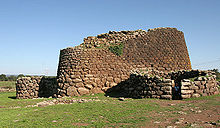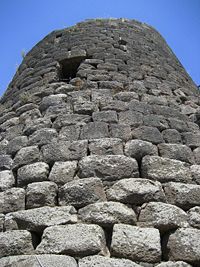- Nuraghe
-
Main article: Nuragic civilization
The nuraghe [nuˈraɡe] (plural Italian nuraghi, Sardinian nuraghes) is the main type of ancient megalithic edifice found in Sardinia. Today it has come to be the symbol of Sardinia and its distinctive culture, the Nuragic civilization. According to the Oxford English Dictionary the etymology is "uncertain and disputed": "The word is perhaps related to the Sardinian place names Nurra, Nurri, Nurru, and to Sardinian nurra heap of stones, cavity in earth (although these senses are difficult to reconcile). A connection with the Semitic base of Arabic nūr light, fire ... is now generally rejected."[1] The latin word "murus" (wall) may be related to it (M. Pittau, philologist), as the old Italian word "mora" (tombal rock mound), as used by Dante in his "Comedy". The derivation: murus-muraghe-nuraghe is debated.
The typical nuraghe is situated in areas where previous Prehistoric Sardinians Cultures had been distributed, that is not far from alluvial plains (though few nuraghi appear in plains nowadays, as they were destroyed by human activities such as agriculture, dams and others) and has the shape of a truncated conical tower resembling a medieval tower (outside) or a beehive (inside). The structure's walls consist of three components: an outer layer (tilted inwards and made of many layers of stones whose size diminishes with height) shaped like a tower, an inner layer, made of smaller stones (to form a bullet shaped dome called "Tholos"), an intermediate layer of very small pieces and dirt, which makes the whole construction very sturdy: it stands only by virtue of the weight of its stones, which may each amount to several tons. Some nuraghes are about 20 metres (60 ft) in height. A spiral stone stair was built within the thick walls, leading to upper floors (if present) and/or to a terrace.
Today, there are little less than 7,000 nuraghes still extant in Sardinia, although their number was somewhat larger, originally. Nuraghes are most prevalent in the northwest and south-central parts of the island.[2]
There is a similar type of structure which has a corridor or a system of corridors. Some authors consider them somewhat older than the typical nuraghe and probably serving different purposes.
The nuraghes were built between the middle of the Bronze Age (18th-15th centuries BC) and the Late Bronze Age. This clearly rules out any possible cultural correlation with later towers such as Scottish Brochs and Israelian El Awhat. The only similar buildings related to nuraghi seem to be Corse Towers.
According to Massimo Pallottino, a scholar of Sardinian prehistory and an Etruscologist, the architecture produced by the Nuragic civilization was the most advanced of any civilization in the western Mediterranean during this epoch, including those in the regions of Magna Graecia.[3] Of the 7,000 extant nuraghes, only a few have been scientifically excavated. Undoubtedly, many Nuragic Cultural traits and values were inherited by the Etruscans and by the Romans.
 Nuraghe la Prisciona, Nuraghe village near Arzachena, Sardinia
Nuraghe la Prisciona, Nuraghe village near Arzachena, Sardinia
There is no consensus on the function of the nuraghes: they could have been religious temples, ordinary dwellings, rulers' residences, military strongholds, meeting halls, or a combination of the former. Some of the nuraghes are, however, located in strategic locations – such as hills – from which important passages could be easily controlled. They might have been something between a "status symbol" and a "passive defence" building, meant to be a deterrent for possible enemies.
Nuraghes could also have been the "national" symbol of the Nuragic peoples. Small-scale models of nuraghe have often been excavated at religious sites (e.g. in the "maze" temple at the Su Romanzesu site near Bitti in central Sardinia). Nuraghes may have just connoted wealth or power, or they may have been an indication that a site had its owners. Recent unconfirmed theories tend to suggest that Sardinian towns were independent entities (such as the city-states, although in a geographical sense they were not cities) that formed federations and that the building of these monuments might have depended on agreed-on distributions of territory among federated unities.
Contents
Notable nuraghes
The most important complex is Su Nuraxi di Barumini, which was inscribed on the UNESCO World Heritage Site list. The highest and most imposing one is the Nuraghe Sant' Antine near the village of Torralba. Other famous nuraghes are near Alghero, Macomer, Abbasanta (see Losa), Orroli, and Villanovaforru.
See also
- Ahwat
- Arzachena
- Beehive tomb
- Broch
- Giants' grave
- Motillas (Iberian Nuraghe-like fortresses of La Mancha)
- Nuragic civilization
- Sherden
- Talaiot
Notes
External links
Categories:- Archaeology of Sardinia
- Monument types
- Buildings and structures in Sardinia
Wikimedia Foundation. 2010.



